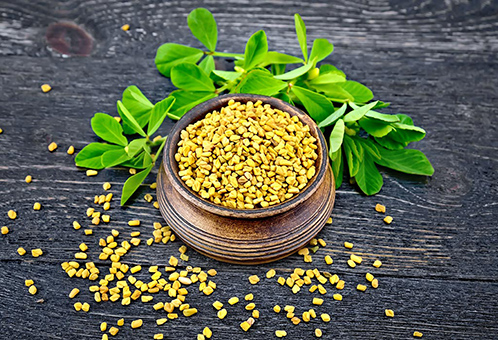Contents
The fenugreek plant is one of the world’s most ancient medicinal herbs. The Ebers Papyrus, an Egyptian medical document dated in the 15th century B.C., recommended fenugreek as a burn-healing plant.
Hippocrates remarked on the healing properties of its flour mucilage. In Arab countries, it is still cultivated as a forage for cattle. Its Latin name (foenum graecum = Greek hay) refers to its widespread cultivation in all Mediterranean countries, especially Greece, despite being native to the Middle East.

Healing Properties and Indications
The seeds of fenugreek are rich in mucilage and protein. They have a mild laxative action when internally used, besides reducing inflammation and protecting all digestive mucosa (an emollient property of mucilage). This fact makes all digestive processes more active, promoting a better metabolism of other foods.
Moreover, the fenugreek plant supplies quickly assimilated proteins (27% of its seed weight), minerals (iron, phosphorus, sulfur), and vitamins. Thus, Eastern women use it to gain weight according to their countries’ beauty fashions.
Though there are many stimulating substances, fenugreek seed flour is still a highly recommended remedy for people suffering from lack of appetite or anemia and those who want to gain weight. It produces an increase in appetite and natural weight gain. It has been successfully used in tuberculosis recovery.
Maybe the most typical application of the fenugreek plant is in external use. Decoctions of fenugreek seeds produce a paste rich in mucilage, which is highly effective in the following cases:
- Hemorrhoids: When directly applied on the anus, in the form of cold poultice, or sitz baths, it reduces the inflammation of hemorrhoids.
- Skin afflictions: Wounds that will not heal or cure ulcers, nipple, and lip cracks, applied in poultices: it cleans them and promotes their healing. Fenugreek is also helpful for abscesses, furuncles, infected sores, and cellulitis since it encourages skin cleansing.
- Inflamed or aching joints: Arthritis, arthrosis, joint rheumatism, also in the form of a hot poultice.
Fenugreek has been used medicinally for a long time; it is one of the oldest herbal plants. Hippocrates and ancient Egyptians widely used it. It is helpful in all mucous ailments involving the lungs. People suffering from tuberculosis or recovering from an illness are given copious amounts of a fenugreek plant decoction. The herb is also suitable for excessive gas, sciatica, neuralgia, migraines, hoarseness, heartburn, hay fever, emphysema, asthma, gout, diabetes, ulcers, stomach ailments, bronchitis, and fevers.
Because it reduces mucous, it benefits people with sinus problems and asthma. Fenugreek also can stimulate lactation in nursing mothers. The plant also lowers blood sugar levels and cholesterol and is suitable for the eyes.
In external applications, fenugreek is utilized for skin conditions, dry skin, sore throat, abscesses, carbuncles, and boils. Fenugreek plant tea is an excellent remedy for sore throat (gargle and drink). The plant’s pulverized seeds can make a poultice that can be placed on fistulas, skin irritations, swollen glands, and areas of gout pains, sores, tumors, and wounds.
NOTE: The taste of the herb can be enhanced and improved by combining it with honey, lemon extract, or peppermint oil.

Fenugreek Plant Scientific Facts
- French: Fenugrec.
- Spanish: Alholva.
- Environment: Native to the Middle East and introduced to Europe in the Middle Ages, it grows in wheat, cereals, and farmed soils.
- Description: Plant of the Leguminosae family, growing up to 50 cm high. The seeds (10-20) are in large, narrow pods. The whole plant has a typical aroma, not very pleasant.
- Parts of the plant used medicinally: The seeds.
How to use Fenugreek

- Decoction with a spoonful of seed flour per cup of water. Take it as a puree. Honey or brown sugar can be added to this puree.
- Dry extract: One gram is recommended in all three daily meals.
- Decoction with 100g of ground seeds (or seed flour) per liter of water. Boil for 15 minutes. Apply as a poultice on the affected area (cold for hemorrhoids, hot in all other cases).
- Sitz baths with two or three liters of the above decoction are cold.
Infusion: Steep for five to fifteen minutes and take one cup during the day, hot or cold. Tincture: Thirty to sixty drops three times a day. Fluid Extract: Take ½ to one teaspoon three times a day. Powder: Take two to ten #0 capsules (10 to 60 grains) daily.
DISCLAIMER: All content on this website is presented solely for educational and informational objectives. It would be best to not rely on the information provided as a replacement for advice, diagnosis, or treatment from a qualified medical expert. If you are pregnant, nursing, or have any preexisting medical concerns, you should talk to your doctor before using any herbal or natural medicines.
REFERENCES
- George D. Pamplona-Roger, M.D. “Encyclopedia of Medicinal Plants.” George D. Pamplona-Roger, M.D. Encyclopedia of Medicinal Plants. Ed. Francesc X. Gelabert. vols. 2 San Fernando de Henares: Editorial Safeliz, 2000. 474. Print. [Fenugreek plant]
- Vance Ferrell Harold M. Cherne, M.D. The Natural Remedies Encyclopedia [Book]. – Altamont, TN: Harvestime Books, 2010. – Vol. Seventh Edition: 7: pp. 158.
- Dermatitis – “Herbal Medicine in Dermatology”: https://pubmed.ncbi.nlm.nih.gov/29489250/
- American Family Physician – “Herbal Products and Supplements: What Physicians Need to Know”: https://www.aafp.org/afp/2017/0101/p35.html
